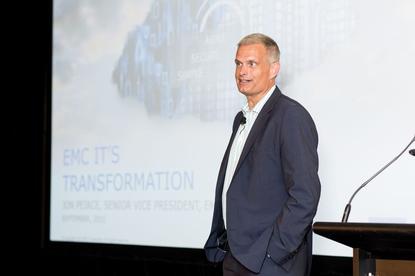Transformation requires making big bets: EMC’s Jon Peirce
- 15 September, 2015 14:16

EMC's Jon Peirce: "We’re detecting and remediating potential situations before they evolve into risks."
Jon Peirce was frank about the biggest driver that forced EMC, one of the largest technology providers worldwide, to transform its own IT operations: the threat of becoming irrelevant.
“When IT is a monopoly you don’t have to worry,” said Peirce, senior vice president, IT at EMC at the ANZ CIO Forum.
But
with a large tech savvy workplace, “If you don’t get the job done they take the
matter in their own hands and work around it.
“We realised if we did not do something, we will wake up at one point and find the only value we were providing to the company was... a pipeline to the internet,” he said.
Peirce discussed EMC’s own IT transformation and the lessons other organisations can learn from the tech giant’s experience.
An analogy he used to describe the transformation was having the ICT team undertake an orienteering journey. They were blindfolded and dropped off somewhere and told they had to get to Antarctica.
He says that armed with a compass, the only thing they knew was that they had to go South.
“We knew we will probably run into a mountain, probably run into water, and all the obstacles. We had a direction but we did not have all the details on how to get the desired end state,” he said.
In 2004, EMC began transforming its IT, starting with an assessment of what the company had and where it planned to be. The business units saw IT as slow, expensive, restricted and to be avoided. The CFO saw IT as a ‘regulated monopoly’, a cost centre just responsible for ‘keeping the lights on’.
Peirce also saw ICT as 100 per cent reactive and “losing control” with the rise of shadow IT.
From 2005 to today, EMC embarked on three ‘progressive stages. “We made some big bets,” he said.
The first was ‘ruthless standardisation' using cloud infrastructure, then to a 'cultural revolution' using the IT-as-a-service operating model and then to “transformation” where IT moves up the value stack and helps the company deliver competitive advantage.
"We started with infrastructure because that seems to be the big problem. We did not have two of everything,” he said, referring to the pair of animals in Noah’s Ark.
“We had one of everything.” This was a legacy of the 75 companies EMC has acquired through the years. They took cues from Google on utility computing, as the term ‘cloud’ was not discussed at that time.
EMC had used its own technologies and partner organisations for the transformation like VMware, Pivotal and RSA.
The cost savings were important but the real value they delivered has been the speed, the agility, the ability to be more relevant and more consultative, he said.
“Standardisation has allowed us to automate things not possible in the past when we had different point solutions in place. It also enabled us to absorb triple the company size with the same footprint in spending when the company was a third in size.”
To put this into context, in 2004 when they started the transformation journey, EMC had 24,000 employees. The current staff count is 65,000.
In 2004, it took the IT team 90 days to provision an app environment; today it is down to less than a day. They used to spend 80 per cent of the budget to “lights on” systems. This is now down to 58 per cent.
The IT group also helped in revenue generation, working with sales and marketing, to find areas of “revenue leakage”. They looked at opportunities to apply big data and saw this in cybersecurity, Pierce said.
“We believe the security challenge today is a big data challenge,” he explained. “You can not prevent everything from happening. If you do you will so inconvenience your users they will find the ways around you to get what they need to get done and ultimately, that is a greater risk to the business.
So EMC implemented a security strategy using big data technology.
“We’re detecting and remediating potential situations before they evolve into risks for the business,” said Peirce.
He says the company has also established a sales force for IT, who are more than just ‘order takers’. These are IT staff who are skilled to be more consultative, able to have demand shaping conversations with their business units, and earn a seat at the table where decisions are being made.
"Our ultimate goal is to become a software-defined enterprise, he said. "We are operating more like a business than ever in the past.”
He points to the fact that the transformation has moved the IT organisation up the “value stack” and providing “competitive advantage”.
“Real transformation is a test of leadership and change management acumen, “ he stated. “You must engineer simplicity into everything. We are confident we are going in the right way, we have to continuously up the speed, and never say we are done.
“We will continue to transform, it will never end.”

